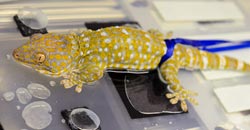Gecko feet hold clues to creating bandages that stick when wet

A gecko's adhesion is tested on a wet surface.<br>
Place a single water droplet on the sole of a gecko toe, and the pad repels the water. The anti-wetting property helps explain how geckos maneuver in rainy tropical conditions. However, saturate that same toe pad in water or drench the surface on which it climbs, and adhesion slips away, the researchers say.
As researcher Alyssa Stark, a doctoral candidate in UA’s Integrated Bioscience Program and research team leader explains, geckos don’t fall from trees during downpours in the tropics. What, then, makes them stick? The team hopes to make that discovery in order to create synthetic materials that hold their grip in wet environments, such as inside the body, for surgical procedures.
Findings by Stark, Timothy Sullivan, who received his bachelor’s degree in biology in May, and Peter Niewiarowski, UA professor of biology and integrated bioscience, are published in the August 9, 2012 issue of The Journal of Experimental Biology.
Researchers Alyssa Stark and Tim Sullivan test the adhesion of a geckos feet in water. Their findings may help improve the adhesion of bandages, sutures and similar items in moist environments.
“We’re gathering many clues about how geckos interact with wet surfaces and this gives us ideas of how to design adhesives that work under water,” says Ali Dhinojwala, UA department of polymer science chair and Morton professor of polymer science. “Nature gives us a certain set of rules that point us in the right direction. They help us understand limitations and how to manipulate materials.”
Stark and her research team members tested gecko toe hair adhesion in a series of scenarios: dry toe pads on dry, misted and wet surfaces and soaked toe pads on dry, misted and wet glass. The soaked toe pads demonstrated low to no adhesion proportionately with the wetness of the surface on which they were applied and pulled. Likewise, dry toe pads lost their adhesive grip increasingly with the amount of water applied to the surface upon which they were pulled. For the experiments, geckos were pulled on a glass surface by way of a small, gentle harness placed around their midsections.
“There were anecdotes before the study that geckos can’t stick to wet glass. We now know it is a bit more complicated than that. What we expect to learn is going to be relevant to synthetics and ther capabilities to work not only on dry surfaces, but also wet and maybe, submerged ones,” Niewiarowski says. “This implies a more versatile adhesive capability.”
Gecko-inspired dry adhesive
After close study of the tiny hairs at the bottom of gecko feet that enable them to cling to surfaces, Dhinojwala and his colleagues have already developed a dry synthetic adhesive, comprised of carbon nanotubes, that outperforms nature’s variety. Now, with these new findings, Dhinojwala and his colleagues are one step closer to unfolding the secrets behind gecko toe adhesion in wetness.
The researchers plan to further study the lizards in their natural habitats and in laboratory conditions that simulate them. They’ll investigate grasping and release mechanisms, habits of the geckos in wet environments and other factors that enable the lizards to adhere to surfaces in wetness, such as to trees during rainfalls.
“Our goal is to go back and look at what they’re doing in nature and at what kind of surfaces they are walking or running on,” says Stark, noting that UA researchers have already studied such behavior of geckos in Tahiti.
Media Contact
More Information:
http://www.uakron.eduAll latest news from the category: Life Sciences and Chemistry
Articles and reports from the Life Sciences and chemistry area deal with applied and basic research into modern biology, chemistry and human medicine.
Valuable information can be found on a range of life sciences fields including bacteriology, biochemistry, bionics, bioinformatics, biophysics, biotechnology, genetics, geobotany, human biology, marine biology, microbiology, molecular biology, cellular biology, zoology, bioinorganic chemistry, microchemistry and environmental chemistry.
Newest articles

Superradiant atoms could push the boundaries of how precisely time can be measured
Superradiant atoms can help us measure time more precisely than ever. In a new study, researchers from the University of Copenhagen present a new method for measuring the time interval,…

Ion thermoelectric conversion devices for near room temperature
The electrode sheet of the thermoelectric device consists of ionic hydrogel, which is sandwiched between the electrodes to form, and the Prussian blue on the electrode undergoes a redox reaction…

Zap Energy achieves 37-million-degree temperatures in a compact device
New publication reports record electron temperatures for a small-scale, sheared-flow-stabilized Z-pinch fusion device. In the nine decades since humans first produced fusion reactions, only a few fusion technologies have demonstrated…





















